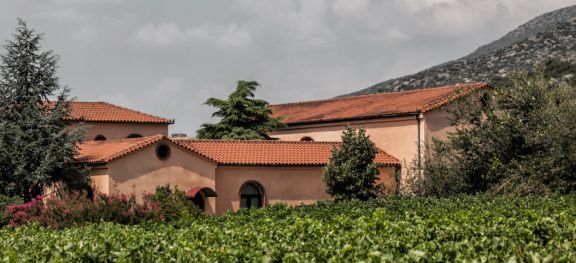Dougos 2018 Rapsani

From €10.90, $20, 19.50 Swiss francs, £19.49
Rapsani is a classic among Greek red wines. Created in 1932 and named after a village in the foothills of Mount Olympus (seen above rising up on the right behind the Dougos winery), this appellation on the eastern coast of central Greece, as this map shows, requires a blend of three unique and distinctive Greek grape varieties: Xinomavro, Krasato and Stavroto. In this instance, it’s a 40/40/20 blend though they are often in equal parts. At the time of the appellation’s creation, more than 50% of the villagers derived their income from viticulture.
Dougos make two versions of Rapsani, this one, with the white label, is from their younger vines, though 30+ years would be old in many wine regions. Their Rapsani Old Vines – red and black label – is also excellent and made from vines planted in 1952.
I tasted the Dougos 2018 Rapsani over about a week, at various temperatures, and it seemed to get better and better (a good indication – though not an infallible one – of its ageing potential) and was most delicious slightly cool after a couple of days, so it may be worth giving this some air by putting it into a decanter or simply pouring it into a jug and then back into the bottle.
The slightly cooler temperature highlighted its lovely fragrance of both fresh and senescent red fruit (senescent in the sense that it has just started to lose its primary fruit flavour after a couple of years in the bottle but was clearly picked when the fruit was very much alive and vibrant). It has floral notes but also a more savoury side to it, perfumed umami, if language may be stretched in that way. The aroma is so complex and intriguing it is hard to move on to actually taste the wine. When I did, I was struck by its dry tannic finesse and freshness, which made it a versatile partner at the table.
The grapes were harvested by hand from schist soil rich in iron. According to viticulturist Thanos Dougos – his sister Louiza is a chemist and winemaker – ‘The iron in the soil is an important quality factor, since it regulates the water capacity of the soil. The soil is poor in organic substances. Its structure enables the penetration of the roots into the subsoil, so that the vine does not suffer from lack of moisture during the summer [the vines are not irrigated]. The subsoil is sandy-clay.’
The freshness that is so perfectly judged in this young wine is enhanced by the inclusion of 20% whole bunches in the fermentation. The refined texture has benefited from 12 months on the lees in 300-litre mostly American oak (20% new). This is one of the few wines I have come across in which the use of American oak does not result in a noticeable woody/vanillin sweetness. (Ridge, in the Santa Cruz Mountains, are the firmly established trailblazers in how to season and use American oak.)
When I asked Thanos how he and his sister came to be winegrowers, he explained that his mother’s family owned one of the first vine nurseries founded in Greece, in 1956. His father, an economist, started to make wine in 1980 in an ‘artisanal style’ and began planting vines in 1991, both Greek and international varieties.
Thanos and Louiza were ‘prepared’ to take over the estate, he went on. ‘Winemaking is a virus, you know, for children growing in that environment.’ Unlike most infections, this was clearly a very benevolent one.
A critical factor in the style of the wine, as in so many great wines, is geography. The cooling effect of elevation (520–580 m/1,700–1,900 ft) is increased by the influence of the nearby Aegean Sea and the Tempi Valley (the gorge pictured below), between Mount Olympus, which is actually a series of peaks, and the Ossa Mountains. The mountain winds bring cool air, especially at night. If you want to see more of the landscape, there’s a 10-minute video on their website.
Dougos are also unusual in having mature Assyrtiko vines. Thanos praises his father’s vision in the early 1990s: ‘Our father proved to be very insightful if you consider that in 1991 he planted for example Assyrtiko, which was still not appreciated even on Santorini. He planted Limniona, Roditis and international varieties such as Sauvignon Blanc, Syrah and Grenache. At that time, everyone was planting Cabernet Sauvignon, Merlot, Chardonnay and did not even see the future in Greek varieties. For the three local Rapsani varieties he preferred to buy two already planted old vineyards because he knew that he did not have to wait years to produce complex wines. Generally at that time consumers asked for international varieties!’ (See Greece backs indigenous varieties for views collected during a visit to northern Greece in 2008.)
2018 is the current vintage of this wine in the UK, the US and Greece but it looks as though there is some 2017 still available, which is likely to have even more complex flavours of bottle-aged Xinomavro – sometimes likened to Nebbiolo – and was very good when I tasted it last year, scoring it 17 out of 20, as I did the 2018. These are wines that will age well in the bottle (probably for up to a decade after the harvest) but both vintages are drinking well now and have masses of aromatic appeal in youth.
US importer is Cava Oinos, who distribute this wine in New York, Florida, Massachusetts, Connecticut and New Jersey. Contact Nikolaos Nichoritis (via info@cavaoinos.com) for specific retailers and (mostly Greek) restaurants. He’s clearly doing a good job as Thanos Dougos reports particularly good sales in New York City – a whopping 25% of their production. Bancroft Wines started importing Dougos wines into the UK in 2020 and you can buy directly from them. For other countries, see the comprehensive and up-to-date list of distributors on the Dougos website.
If this has whetted your appetite for Greek wines, see our long list of articles tagged Greece and especially last week's collection of recent releases and another Greek red wine of the week from late last year.
Become a member to view this article and thousands more!
- 15,407 featured articles
- 274,946 wine reviews
- Maps from The World Atlas of Wine, 8th edition (RRP £50)
- The Oxford Companion to Wine, 5th edition (RRP £50)
- Members’ forum
- 15,407 featured articles
- 274,946 wine reviews
- Maps from The World Atlas of Wine, 8th edition (RRP £50)
- The Oxford Companion to Wine, 5th edition (RRP £50)
- Members’ forum
- 48-hour preview of all scheduled articles
- Commercial use of our wine reviews




